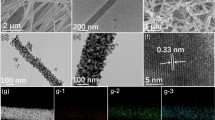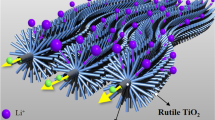Abstract
The C–ZnCo2O4–ZnO nanorod arrays (NRAs), which consist of MOF-derived carbon coating on ZnCo2O4–ZnO NRAs, are rational designed and synthesized via a facile template-based solution route on Ti foil and used as high-performance anode for lithium-ion batteries (LIBs). The uniform coated MOF-derived carbon layers on the ZnCo2O4–ZnO nanorods surface can serve as a conductive substrate as well as buffer layer to restrain volume expansion during charge–discharge process. When tested as anodes for LIBs, the C–ZnCo2O4–ZnO NRAs show high reversible capacity of 1318 mA h g−1 at 0.2 A g−1 after 150 charge–discharge cycles. Furthermore, C–ZnCo2O4–ZnO NRAs also exhibit brilliant rate performance of 886.2, 812.8, 732.2 and 580.6 mA h g−1 at 0.5, 1, 2 and 5 A g−1, respectively. The outstanding lithium storage performance of C–ZnCo2O4–ZnO NRAs could be ascribed to the stimulated kinetics of ion diffusion and electron transport originated from the shortened lithium-ion diffusion pathway and improved electronic conductivity benefit from uniformly coating MOF-derived carbon.






Similar content being viewed by others
References
Pan L, Zhao H, Shen W, Dong X, Xu J (2013) Surfactant-assisted synthesis of a Co3O4/reduced graphene oxide composite as a superior anode material for Li-ion batteries. J Mater Chem A 1:7159–7166. doi:10.1039/c3ta01498c
Wang Y, Yan F, Liu SW et al (2013) Onion-like carbon matrix supported Co3O4 nanocomposites: a highly reversible anode material for lithium ion batteries with excellent cycling stability. J Mater Chem A 1:5212–5216. doi:10.1039/c3ta10559h
Zhuo L, Wu Y, Ming J et al (2013) Facile synthesis of a Co3O4-carbon nanotube composite and its superior performance as an anode material for Li-ion batteries. J Mater Chem A 1:1141–1147. doi:10.1039/c2ta00284a
Qiu Y, Yang S, Deng H, Jin L, Li W (2010) A novel nanostructured spinel ZnCo2O4 electrode material: morphology conserved transformation from a hexagonal shaped nanodisk precursor and application in lithium ion batteries. J Mater Chem 20:4439–4444. doi:10.1039/c0jm00101e
Sun J, Li D, Xia Y et al (2015) Co3O4 nanoparticle embedded carbonaceous fibres: a nanoconfinement effect on enhanced lithium-ion storage. Chem Commun (Camb) 51:16267–16270. doi:10.1039/c5cc06160a
Zhu Y, Cao C, Zhang J, Xu X (2015) Two-dimensional ultrathin ZnCo2O4 nanosheets: general formation and lithium storage application. J Mater Chem A 3:9556–9564. doi:10.1039/c5ta00808e
Wang Y, Ke J, Zhang Y, Huang Y (2015) Microwave-assisted rapid synthesis of mesoporous nanostructured ZnCo2O4 anode materials for high-performance lithium-ion batteries. J Mater Chem A 3:24303–24308. doi:10.1039/c5ta06949a
Sharma Y, Sharma N, Subba Rao GV, Chowdari BVR (2007) Nanophase ZnCo2O4 as a high performance anode material for Li-ion batteries. Adv Funct Mater 17:2855–2861. doi:10.1002/adfm.200600997
Wu R, Qian X, Zhou K, Wei J, Lou J, Ajayan PM (2014) Porous spinel Zn x Co3−x O4 hollow polyhedra templated for high-rate lithium-ion batteries. Acs Nano 8:6297–6303. doi:10.1021/nn501783n
Park HJ, Kim J, Choi NJ, Song H, Lee DS (2016) Nonstoichiometric Co-rich ZnCo2O4 hollow nanospheres for high performance formaldehyde detection at ppb levels. Acs Appl Mater Interfaces 8:3233–3240. doi:10.1021/acsami.5b10862
Xu X, Cao K, Wang Y, Jiao L (2016) 3D hierarchical porous ZnO/ZnCo2O4 nanosheets as high-rate anode material for lithium-ion batteries. J Mater Chem A 4:6042–6047. doi:10.1039/c6ta00723f
Liu B, Zhang J, Wang X et al (2012) Hierarchical three-dimensional ZnCo2O4 nanowire arrays/carbon cloth anodes for a novel class of high-performance flexible lithium-ion batteries. Nano Lett 12:3005–3011. doi:10.1021/nl300794f
Luo W, Hu X, Sun Y, Huang Y (2012) Electrospun porous ZnCo2O4 nanotubes as a high-performance anode material for lithium-ion batteries. J Mater Chem 22:8916–8921. doi:10.1039/C2JM00094F
Li Z, Yin L (2015) Sandwich-like reduced graphene oxide wrapped MOF-derived ZnCo2O4–ZnO–C on nickel foam as anodes for high performance lithium ion batteries. J Mater Chem A 3:21569–21577. doi:10.1039/c5ta05733g
Cheng H, Lu ZG, Deng JQ, Chung CY, Zhang K, Li YY (2010) A facile method to improve the high rate capability of Co3O4 nanowire array electrodes. Nano Res. 3:895–901. doi:10.1007/s12274-010-0063-z
Li Q, Lu XF, Xu H, Tong YX, Li GR (2014) Carbon/MnO(2) double-walled nanotube arrays with fast ion and electron transmission for high-performance supercapacitors. Acs Appl Mater Interfaces 6:2726–2733. doi:10.1021/am405271q
Liu J, Song K, van Aken PA, Maier J, Yu Y (2014) Self-supported Li4Ti5O12–C nanotube arrays as high-rate and long-life anode materials for flexible Li-ion batteries. Nano Lett 14:2597–2603. doi:10.1021/nl5004174
Feckl JM, Fominykh K, Döblinger M et al (2012) Nanoscale porous framework of lithium titanate for ultrafast lithium insertion. Angew Chem Int 51:7459–7463. doi:10.1002/anie.201201463
Jung HG, Myung ST, Chong SY et al (2011) Microscale spherical carbon-coated Li4Ti5O12 as ultra high power anode material for lithium batteries. Energy Environ Sci 4:1345–1351. doi:10.1039/C0EE00620C
Wang YQ, Gu L, Guo YG et al (2012) Rutile-TiO2 nanocoating for a high-rate Li4Ti5O12 anode of a lithium-ion battery. J Am Chem Soc 134:7874–7879. doi:10.1021/ja301266w
Worrall SD, Bissett MA, Hirunpinyopas W, Attfield MP, Dryfe RAW (2016) Facile fabrication of metal–organic framework HKUST-1-based rewritable data storage devices. J Mater Chem C 4:8687–8695. doi:10.1039/c6tc03496a
Quartarone E, Dall’Asta V, Resmini A et al (2016) Graphite-coated ZnO nanosheets as high-capacity, highly stable, and binder-free anodes for lithium-ion batteries. J Power Sources 320:314–321. doi:10.1016/j.jpowsour.2016.04.107
Feng Y, Zou R, Xia D, Liu L, Wang X (2013) Tailoring CoO–ZnO nanorod and nanotube arrays for Li-ion battery anode materials. J Mater Chem A 1:9654–9658. doi:10.1039/c3ta11538k
Yuan C, Wu HB, Xie Y, Lou XWD (2014) Mixed transition-metal oxides: design, synthesis, and energy-related applications. Angew Chem Int Ed 53:1488–1504. doi:10.1002/anie.201303971
Geng H, Ang H, Ding X et al (2016) Metal coordination polymer derived mesoporous Co3O4 nanorods with uniform TiO2 coating as advanced anodes for lithium ion batteries. Nanoscale 8:2967–2973. doi:10.1039/c5nr08570e
Zhang X, Chen H, Xie Y, Guo J (2014) Ultralong life lithium-ion battery anode with superior high-rate capability and excellent cyclic stability from mesoporous Fe2O3@TiO2 core–shell nanorods. J Mater Chem A 2:3912–3918. doi:10.1039/c3ta14317a
Huang G, Zhang F, Zhang L, Du X, Wang J, Wang L (2014) Hierarchical NiFe2O4/Fe2O3 nanotubes derived from metal organic frameworks for superior lithium ion battery anodes. J Mater Chem A 2:8048–8053. doi:10.1039/c4ta00200h
Zhang G, Hou S, Zhang H et al (2015) High-performance and ultra-stable lithium-ion batteries based on MOF-derived ZnO@ZnO quantum dots/C core–shell nanorod arrays on a carbon cloth anode. Adv Mater 27:2400–2405. doi:10.1002/adma.201405222
Liu B, Shioyama H, Akita T, Xu Q (2008) Metal–organic framework as a template for porous carbon synthesis. J Am Chem Soc 130:5390–5391. doi:10.1021/ja7106146
Chaikittisilp W, Ariga K, Yamauchi Y (2013) A new family of carbon materials: synthesis of MOF-derived nanoporous carbons and their promising applications. J Mater Chem A 1:14–19. doi:10.1039/c2ta00278g
Zhong S, Zhan C, Cao D (2015) Zeolitic imidazolate framework-derived nitrogen-doped porous carbons as high performance supercapacitor electrode materials. Carbon 85:51–59. doi:10.1016/j.carbon.2014.12.064
Cheng F, Li WC, Zhu JN, Zhang WP, Lu AH (2016) Designed synthesis of nitrogen-rich carbon wrapped Sn nanoparticles hybrid anode via in situ growth of crystalline ZIF-8 on a binary metal oxide. Nano Energy 19:486–494. doi:10.1016/j.nanoen.2015.10.033
Wang J, Sun X (2012) Understanding and recent development of carbon coating on LiFePO4 cathode materials for lithium-ion batteries. Energy Environ Sci 5:5163–5185. doi:10.1039/c1ee01263k
Zhan WW, Kuang Q, Zhou JZ, Kong XJ, Xie ZX, Zheng LS (2013) Semiconductor@metal–organic framework core–shell heterostructures: a case of ZnO@ZIF-8 nanorods with selective photoelectrochemical response. J Am Chem Soc 135:1926–1933. doi:10.1021/ja311085e
Liu X, Chang Z, Luo L et al (2014) Hierarchical Zn x Co3−x O4 nanoarrays with high activity for electrocatalytic oxygen evolution. Chem Mater 26:1889–1895. doi:10.1021/cm4040903
Menezes PW, Indra A, Bergmann A et al (2016) Uncovering the prominent role of metal ions in octahedral versus tetrahedral sites of cobalt-zinc oxide catalysts for efficient oxidation of water. J Mater Chem A 4:10014–10022. doi:10.1039/c6ta03644a
Guo L, Ru Q, Song X, Hu S, Mo Y (2015) Pineapple-shaped ZnCo2O4 microspheres as anode materials for lithium ion batteries with prominent rate performance. J Mater Chem A 3:8683–8692. doi:10.1039/c5ta00830a
Niu H, Yang X, Jiang H et al (2015) Hierarchical core–shell heterostructure of porous carbon nanofiber@ZnCo2O4 nanoneedle arrays: advanced binder-free electrodes for all-solid-state supercapacitors. J Mater Chem A 3:24082–24094. doi:10.1039/c5ta07439h
Huang XH, Xia XH, Yuan YF, Zhou F (2011) Porous ZnO nanosheets grown on copper substrates as anodes for lithium ion batteries. Electrochim Acta 56:4960–4965. doi:10.1016/j.electacta.2011.03.129
Gao G, Wu HB, Dong B, Ding S, Lou XW (2015) Growth of ultrathin ZnCo2O4 nanosheets on reduced graphene oxide with enhanced lithium storage properties. Adv Sci 2:1400014. doi:10.1002/advs.201400014
Qu B, Hu L, Li Q, Wang Y, Chen L, Wang T (2014) High-performance lithium-ion battery anode by direct growth of hierarchical ZnCo2O4 nanostructures on current collectors. Acs Appl Mater Interfaces 6:731–736. doi:10.1021/am405238a
Bai J, Li X, Liu G, Qian Y, Xiong S (2014) Anodes: unusual formation of ZnCo2O4 3D hierarchical twin microspheres as a high-rate and ultralong-life lithium-ion battery anode material (Adv Funct Mater 20/2014). Adv Funct Mater 24:3012–3020. doi:10.1002/adfm.201470131
Xie Q, Li F, Guo H et al (2013) Template-free synthesis of amorphous double-shelled zinc-cobalt citrate hollow microspheres and their transformation to crystalline ZnCo2O4 microspheres. Acs Appl Mater Interfaces 5:5508–5517. doi:10.1021/am400696x
Deng J, Lv X, Gao J et al (2013) Facile synthesis of carbon-coated hematite nanostructures for solar water splitting. Energy Environ Sci 6:1965–1970. doi:10.1039/C3EE00066D
Lv X, Deng J, Wang J, Zhong J, Sun X (2015) Carbon-coated a-Fe2O3 nanostructures for efficient anode of Li-ion battery. J Mater Chem A 3:5183–5188. doi:10.1039/C4TA06415A
Mondal AK, Su D, Chen S, Xie X, Wang G (2014) Highly porous NiCo2O4 Nanoflakes and nanobelts as anode materials for lithium-ion batteries with excellent rate capability. Acs Appl Mater Interfaces 6:14827–14835. doi:10.1021/am5036913
Li J, Xiong S, Li X, Qian Y (2012) Spinel Mn1.5Co1.5O4 core–shell microspheres as Li-ion battery anode materials with a long cycle life and high capacity. J Mater Chem 22:23254–23259. doi:10.1039/c2jm35607d
Bissett MA, Worrall SD, Kinloch IA, Dryfe RAW (2016) Comparison of two-dimensional transition metal dichalcogenides for electrochemical supercapacitors. Electrochim Acta 201:30–37. doi:10.1016/j.electacta.2016.03.190
Bruce PG, Scrosati B, Tarascon JM (2008) Nanomaterials for rechargeable lithium batteries. Angew Chem Int Ed 47:2930–2946. doi:10.1002/anie.200702505
Tang H, Dou K, Kaun C-C, Kuang Q, Yang S (2014) MoSe2 nanosheets and their graphene hybrids: synthesis, characterization and hydrogen evolution reaction studies. J Mater Chem A 2:360–364
Zhu Y, Guo H, Wu Y, Cao C, Tao S, Wu Z (2014) Surface-enabled superior lithium storage of high-quality ultrathin NiO nanosheets. J Mater Chem A 2:7904–7911. doi:10.1039/C4TA00257A
Zhou G, Wang DW, Yin LC, Li N, Li F, Cheng HM (2012) Oxygen bridges between NiO nanosheets and graphene for improvement of lithium storage. Acs Nano 6:3214–3223. doi:10.1021/nn300098m
Reddy MV, Yu T, Sow CH et al (2007) α-FeOnanoflakes as an anode material for Li-ion batteries. Adv Funct Mater 17:2792–2799. doi:10.1002/adfm.200601186
Acknowledgements
This work was financially supported by the National Nature Science Foundation of China (Nos: 51372278 and 21303270).
Author information
Authors and Affiliations
Corresponding authors
Electronic supplementary material
Below is the link to the electronic supplementary material.
Rights and permissions
About this article
Cite this article
Gan, Q., Zhao, K., Liu, S. et al. MOF-derived carbon coating on self-supported ZnCo2O4–ZnO nanorod arrays as high-performance anode for lithium-ion batteries. J Mater Sci 52, 7768–7780 (2017). https://doi.org/10.1007/s10853-017-1043-4
Received:
Accepted:
Published:
Issue Date:
DOI: https://doi.org/10.1007/s10853-017-1043-4




